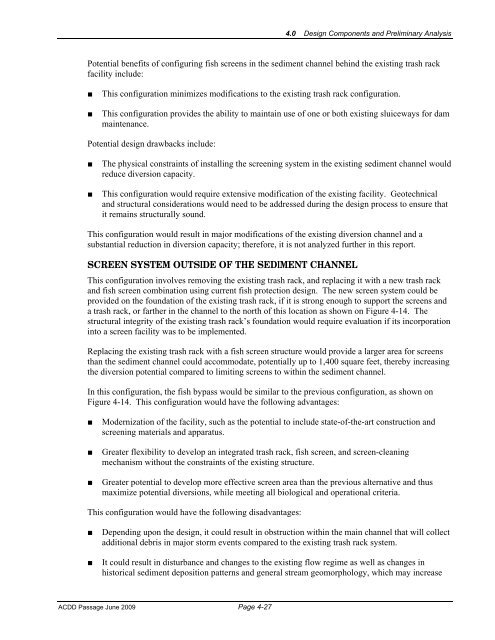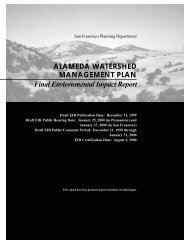Feasibility of Fish Passage at Alameda Creek Diversion Dam
Feasibility of Fish Passage at Alameda Creek Diversion Dam
Feasibility of Fish Passage at Alameda Creek Diversion Dam
Create successful ePaper yourself
Turn your PDF publications into a flip-book with our unique Google optimized e-Paper software.
4.0 Design Components and Preliminary AnalysisPotential benefits <strong>of</strong> configuring fish screens in the sediment channel behind the existing trash rackfacility include:■■This configur<strong>at</strong>ion minimizes modific<strong>at</strong>ions to the existing trash rack configur<strong>at</strong>ion.This configur<strong>at</strong>ion provides the ability to maintain use <strong>of</strong> one or both existing sluiceways for dammaintenance.Potential design drawbacks include:■■The physical constraints <strong>of</strong> installing the screening system in the existing sediment channel wouldreduce diversion capacity.This configur<strong>at</strong>ion would require extensive modific<strong>at</strong>ion <strong>of</strong> the existing facility. Geotechnicaland structural consider<strong>at</strong>ions would need to be addressed during the design process to ensure th<strong>at</strong>it remains structurally sound.This configur<strong>at</strong>ion would result in major modific<strong>at</strong>ions <strong>of</strong> the existing diversion channel and asubstantial reduction in diversion capacity; therefore, it is not analyzed further in this report.SCREEN SYSTEM OUTSIDE OF THE SEDIMENT CHANNELThis configur<strong>at</strong>ion involves removing the existing trash rack, and replacing it with a new trash rackand fish screen combin<strong>at</strong>ion using current fish protection design. The new screen system could beprovided on the found<strong>at</strong>ion <strong>of</strong> the existing trash rack, if it is strong enough to support the screens anda trash rack, or farther in the channel to the north <strong>of</strong> this loc<strong>at</strong>ion as shown on Figure 4-14. Thestructural integrity <strong>of</strong> the existing trash rack’s found<strong>at</strong>ion would require evalu<strong>at</strong>ion if its incorpor<strong>at</strong>ioninto a screen facility was to be implemented.Replacing the existing trash rack with a fish screen structure would provide a larger area for screensthan the sediment channel could accommod<strong>at</strong>e, potentially up to 1,400 square feet, thereby increasingthe diversion potential compared to limiting screens to within the sediment channel.In this configur<strong>at</strong>ion, the fish bypass would be similar to the previous configur<strong>at</strong>ion, as shown onFigure 4-14. This configur<strong>at</strong>ion would have the following advantages:■■■Moderniz<strong>at</strong>ion <strong>of</strong> the facility, such as the potential to include st<strong>at</strong>e-<strong>of</strong>-the-art construction andscreening m<strong>at</strong>erials and appar<strong>at</strong>us.Gre<strong>at</strong>er flexibility to develop an integr<strong>at</strong>ed trash rack, fish screen, and screen-cleaningmechanism without the constraints <strong>of</strong> the existing structure.Gre<strong>at</strong>er potential to develop more effective screen area than the previous altern<strong>at</strong>ive and thusmaximize potential diversions, while meeting all biological and oper<strong>at</strong>ional criteria.This configur<strong>at</strong>ion would have the following disadvantages:■■Depending upon the design, it could result in obstruction within the main channel th<strong>at</strong> will collectadditional debris in major storm events compared to the existing trash rack system.It could result in disturbance and changes to the existing flow regime as well as changes inhistorical sediment deposition p<strong>at</strong>terns and general stream geomorphology, which may increaseACDD <strong>Passage</strong> June 2009 Page 4-27








